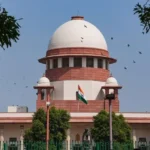The temple, dedicated to Lord Ram, one of Hinduism’s most revered deities, has been at the center of a long-running religious and political conflict in India.

The new Ram Mandir, a Hindu temple dedicated to Lord Ram, one of the most worshipped gods in Hinduism, welcomed half a million visitors on Tuesday, the first day it was open to the public. The temple, located in the sacred town of Ayodhya, has been at the center of a long-running religious and political dispute, as it was built on the site of a demolished 16th century mosque.
Devotees from across the country and abroad flocked to the temple complex, which covers 67 acres and features a grand dome, a museum, a library, and a food court. They carried saffron flags, a symbol of Hinduism, and offered flowers, fruits, and sweets to the deity. Many of them had waited for hours in long queues outside the temple gates, which opened at 7am.
Deva, a 30-year-old pilgrim who had come from the Himalayan town of Shimla, told CNN that he had taken a bath in the nearby river before heading to the temple. “I won’t leave without getting a glimpse of Lord Ram,” he said.
Savitri, a 44-year-old woman who had managed to enter the temple’s inner sanctum, where a new statue of Ram was installed, said that she had been at the gate since 4am. “I went in braving the massive crowds, but thanks to Lord Ram we got a glimpse of his idol inside and I felt as if I had been blessed by him,” she said. “I’m leaving behind all my worries,” she added.
The statue of Ram, made of black stone and depicting him as a young boy, was consecrated on Monday by Prime Minister Narendra Modi, who performed a ritual ceremony called Pran Pratishtha. The statue was decorated with gold jewelry, gemstones, diamonds, and flowers.
Modi, who is a devout Hindu and a member of the Bharatiya Janata Party (BJP), which has championed the cause of building the temple, delivered a speech from the temple premises, which were adorned with colorful flowers and Hindu motifs. He said that the temple was a symbol of India’s cultural and spiritual heritage, and that Ram was not a source of conflict, but a solution.
“Today our Lord Ram has come. After centuries of waiting, our Ram has arrived. After centuries of unprecedented patience, countless sacrifices, renunciations, and penances, our Lord Ram has arrived,” Modi said.
The temple’s inauguration was also attended by hundreds of Hindu priests, who wore saffron robes and took pictures of the statue and the temple’s interiors. They were among the first people to enter the temple after Modi’s ceremony.
Several Indian celebrities also joined the celebrations in Ayodhya, which is considered to be the birthplace of Ram. Among them were Bollywood superstar Amitabh Bachchan, cricket legend Sachin Tendulkar, and business tycoon Mukesh Ambani, who were among the 7,000 guests invited to the ceremony.
Other actors, such as Anupam Kher, who starred in “Bend It Like Beckham,” Ram Charan, who featured in the 2022 blockbuster “RRR,” Alia Bhatt, Ranbir Kapoor, Madhuri Dixit Nene, and Katrina Kaif, were also present at the event.
Outside the temple complex, the streets of Ayodhya were filled with devotees, who prayed in the river and performed various rituals as the ceremony took place. They carried saffron flags, wore flowers around their necks, and chanted religious slogans.
The Ram Mandir is seen by many as the fulfillment of Modi’s vision of creating a “new India,” which is based on Hindu values and identity. However, for his critics, the temple’s inauguration marks the end of a decades-long campaign to undermine India’s secular foundations, which were established after the country’s independence.
The temple was constructed on the site where the Babri Masjid, a 16th century mosque, once stood. The mosque was demolished in 1992 by a mob of Hindu extremists, who claimed that it was built on the spot where Ram was born. The demolition sparked communal riots across the country, which killed more than 2,000 people.
The dispute over the site was settled by the Supreme Court of India in 2019, which ruled that the land belonged to the Hindus and allowed the construction of the temple. The court also ordered that a separate plot of land be given to the Muslims to build a mosque elsewhere in Ayodhya.







